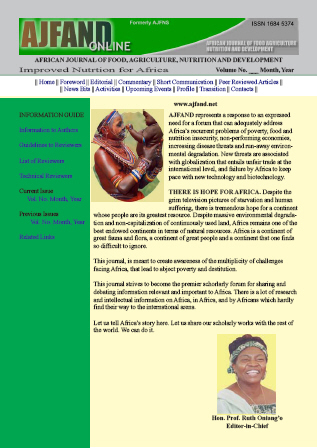
|
African Journal of Food, Agriculture, Nutrition and Development
Rural Outreach Program
ISSN: 1684-5358
EISSN: 1684-5358
Vol. 17, No. 4, 2017, pp. 12657-12677
|
 Bioline Code: nd17087
Bioline Code: nd17087
Full paper language: English
Document type: Research Article
Document available free of charge
|
|
|
African Journal of Food, Agriculture, Nutrition and Development, Vol. 17, No. 4, 2017, pp. 12657-12677
| en |
EFFECT OF SOWING DATE ON GRAIN QUALITY OF SORGHUM ( Sorghum bicolor  L. Moench) IN THE NILE CORRIDOR AGROECOLOGICAL ZONE OF SOUTH SUDAN L. Moench) IN THE NILE CORRIDOR AGROECOLOGICAL ZONE OF SOUTH SUDAN
Kok, MAG; Ouma, JPA & Ojwang, PPO
Abstract
Sorghum (Sorghum bicolor (L.) Moench) is a staple food for a considerable number of
people in Africa and Asia. However, poor grain quality is a major concern for the rural
communities who depend mainly on sorghum grain for food. Protein, minerals and
tannins are important indicators of grain quality. Their quantity is critical in choice of
variety to grow for food. An experiment was carried out in a randomised complete
block design by sowing 5 sorghum varieties on 18th June, 29th June and 10th July 2015 -
in Bor and Arek South Sudan. The objective of the study was to determine the effect of
sowing date on protein, tannins, iron and zinc content in sorghum. Grain samples of
five sorghum varieties sown on various dates were collected and analysed at Kenya
Agricultural and Livestock Research Organization (KALRO) Njoro. Protein content
was determined using method 44 from Association of American Cereal Chemists.
Tannins were determined using the Improved Vanillin- Hydrochloric Acid Assay
(IVHAA) while minerals; iron and zinc were determined using Atomic Absorption
Spectrophotometry. Significant site by variety by sowing date interactions at P < 0.05
level of probability were obtained for protein, iron and zinc content of sorghum
varieties but not for tannins. Highest protein content of 11.55 per cent was achieved
when varieties were sown on 29th June in Bor. Protein of 11.40 per cent was obtained
when varieties were sown on 18th June in Arek. At Bor, Beer, Dhet and Seredo
varieties; 12.76, 11.0 and 10.64 per cent protein respectively were recorded. At Arek,
Beer Seredo and Dhet attained 12.03, 10.92 and 10.60 per cent protein content
respectively. Sorghum varieties sown on 18th June had less tannins of 1.19 mgml-1in
Bor and 1.09 mgml-1in Arek while varieties sown on 10th July had highest tannins 1.49
mgml-1 in Bor and 1.40 mgml-1 in Arek. Amongst the varieties, Seredo and Agany
contained high tannins while Beer and Dhet contained less tannins. Iron and zinc
content in sorghum showed higher values for 29th June sowing date both in Bor and
Arek. The study showed that Beer and Dhet varieties have good quality grains that can
be used to improve human nutrition, hence can be recommended to sorghum farmers in
Bor and Arek region.
Keywords
Sorghum; Date; Grain quality; Cluster; Tannins; Protein; Iron; Zinc
|
| |
© Copyright 2016 - African Journal of Food, Agriculture, Nutrition and Development
Alternative site location: http://www.ajfand.net/
|
|
